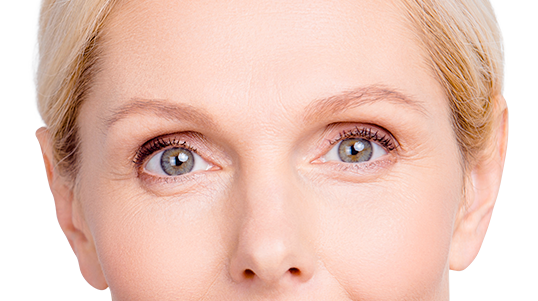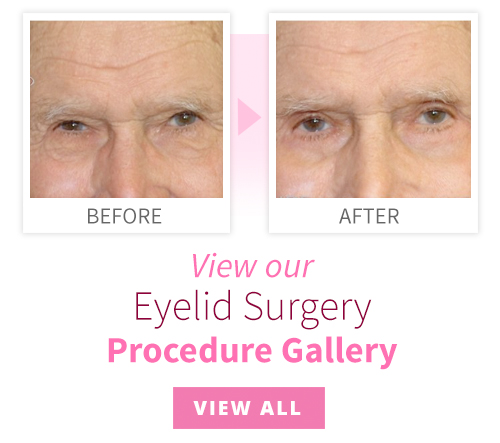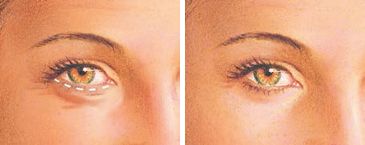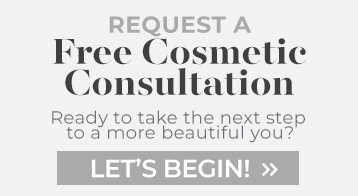Eyelid surgery (blepharoplasty) is designed to remove excess skin and fat from the upper and lower eyelids giving you a more youthful, “awake” look. The procedure can correct drooping upper lids that tend to sag with time and the puffy bags below the eyes. Sutures are generally removed after three or four days. Any bruising may be easily covered by makeup. Blepharoplasty can be done as a separate procedure, or in conjunction with other facial surgery such as a facelift or a browlift.
Procedure Details: Eyelid Surgery
Procedure: Correct drooping upper eyelids and puffy bags below the eyes by removing excess fat, skin, and muscle (Upper-eyelid surgery may be covered by insurance if used to correct visual field defects).
Length: 1 to 3 hours.
Anesthesia: Usually locally with sedation or general.
In/Outpatient: Usually outpatient.
Side Effects: Temporary discomfort, tightness of lids, swelling, bruising. Temporary dryness, burning, itching of eyes. Excessive tearing, sensitivity to light for first few weeks.
Recovery:
- Reading: 2 or 3 days.
- Back to work: 7 to 10 days.
- Contact lenses: two weeks or more.
- Strenuous activities, alcohol: about 3 weeks.
- Bruising and swelling gone: several weeks.
Duration of Results: Several years. Sometimes permanent.
Questions & Answers
What is eyelid surgery?
Eyelid surgery, or blepharoplasty, is a surgical procedure to improve the appearance of the eyelids.
Surgery can be performed on either the upper and lower lids, or both.
Whether you want to improve your appearance or are experiencing functional problems with your eyelids, eyelid surgery can rejuvenate the area surrounding your eyes.
Specifically, eyelid surgery can treat:
- Loose or sagging skin that creates folds or disturbs the natural contour of the upper eyelid, sometimes impairing vision
- Excess fatty deposits that appear as puffiness in the eyelids
- Bags under the eyes
- Drooping lower eyelids that reveal white below the iris
- Excess skin and fine wrinkles of the lower eyelid
Eyelid surgery cost
Your cost will be based on your individual plan and procedure.
Call us at (352) 629-8154 to set up a FREE Consultation.
We offer patient financing plans, so be sure to ask.
Eyelid surgery cost may include:
- Surgeon’s fee
- Hospital or surgical facility costs
- Anesthesia fees
- Prescriptions for medication, and
- Medical tests
When choosing a board-certified plastic surgeon for eyelid surgery, remember that the surgeon’s experience and your comfort with him or her are just as important as the final cost of the surgery.
Eyelid surgery and insurance coverage
Most health insurance does not cover cosmetic surgery or its complications.
When eyelid surgery is performed to eliminate the redundant skin covering the eyelashes, it may be covered by insurance. Carefully review your policy.
Eyelid surgery candidates
In general, good candidates for eyelid surgery include:
- Healthy individuals who do not have a life threatening illness or medical conditions that can impair healing
- Non-smokers
- Individuals with a positive outlook and specific goals in mind for eyelid surgery
- Individuals without serious eye conditions
Remember that the eyelids are part of the face. The appearance of a drooping upper lid may also be due to relaxation of the forehead skin and eyebrow. Sometimes a drooping eyelid is caused by stretching of one of the upper eyelid muscles, the levator.
Your plastic surgeon will evaluate your anatomy thoroughly to determine the causes of your eyelid appearance, and what procedures might best remedy them.
Eyelid surgery recovery
During your eyelid surgery recovery, lubricating ointment and cold compresses may be applied, and in some cases your eyes may be loosely covered with gauze, after your procedure is completed.
You will be given specific instructions that may include how to care for your eyes, medications to apply or take orally to aid healing and reduce the potential for infection, specific concerns to look for at the surgical site or in your overall health, and when to follow-up with your plastic surgeon.
Initial healing may include some swelling, bruising, irritation or dry eyes, and discomfort that can be controlled with medication, cold compresses, and ointment. Irritation at the incision sites is also possible.
Be sure to ask your plastic surgeon specific questions about what you can expect during your individual recovery period.
- Where will I be taken after my surgery is complete?
- What medication will I be given or prescribed after surgery?
- Will I have dressings/bandages after surgery?
- When will they be removed?
- Are stitches removed? When?
- When can I resume normal activity and exercise?
- When do I return for follow-up care?
Eyelid surgery recovery & sun protection
You must practice diligent sun protection and use darkly tinted sunglasses until the healing process is fully complete.
Eyelid surgery before and after results
The results of eyelid surgery will be long-lasting. Your final results will appear within several weeks, but it may take up to a year for incision lines to fully refine.
Eyelid Surgery Before & After Photos
While eyelid surgery can be expected to correct certain conditions permanently, you will continue to age naturally. Life-long sun protection will help to maintain your results.
Satisfaction with your new image should continue to grow as you recover from surgery. As swelling and bruising subside, the results of eyelid surgery will reveal a smooth, better-defined eyelid and surrounding region and an alert and rejuvenated appearance.
Although good results are expected from your procedure, there is no guarantee. In some situations, it may not be possible to achieve optimal results with a single surgical procedure and another surgery may be necessary.
Following your physician’s instructions is essential to the success of your surgery. It is important that the surgical incisions are not subjected to excessive force, abrasion, or motion during the time of healing.
Your doctor will give you specific instructions on how to care for yourself.
Eyelid surgery procedure steps
An eyelid surgery procedure includes the following steps:
Step 1 – Anesthesia
Medications are administered for your comfort during the surgical procedure. The choices include intravenous sedation or general anesthesia. Your doctor will recommend the best choice for you.
Step 2 – The incision
The incision lines for eyelid surgery are designed so the resultant scars will be well concealed within the natural structures of the eyelid region.
The upper eyelid can be corrected through an incision within the natural crease on the eyelid. This allows for removal or repositioning of fat deposits, tightening of muscles, and removal of excess skin.
Conditions of the lower eyelid may be corrected with an incision just below the lower lash line. Through this incision, excess skin in the lower eyelid is removed. Again, the excess fat can be repositioned or removed.
A transconjunctival incision, created on the inside of the lower eyelid, is an alternate technique to correct lower eyelid conditions and redistribute or remove excess fat. With this technique, no skin is removed.
Step 3 – Closing the incisions
Eyelid incisions typically are closed with:
- Removable sutures
- Skin adhesives
- Surgical tape
Your surgeon may suggest use of a laser or chemical peel to reduce discoloration of the lower eyelids.
Step 4 – See the results
The results of eyelid surgery will appear gradually as swelling and bruising subside to reveal a smooth, better-defined eyelid and surrounding region, and an alert and rejuvenated appearance. Get more information about eyelid surgery results. (see tab titled “Eyelid surgery before and after results”)
Eyelid surgery risks and safety information
The decision to have surgery is personal, and you’ll have to decide if it will achieve your goals, and if the potential risks of eyelid surgery are acceptable.
Be sure you understand the surgery and recuperation completely, and don’t hesitate to ask your plastic surgeon questions.
Eyelid surgery risks include:
- Anesthesia risks
- Swelling and bruising
- Bleeding from the incision lines
- Dryness to the eyes
- Sensitivity to sun or other bright light
- Difficulty closing your eyes
- Ectropion, an outward rolling of the eyelid
- Infection
- Lid lag, a pulling down of the lower eyelid may occur and is often temporary
- Temporary or even permanent change in vision, and very rare chance of blindness
- Changes in skin sensation
- Pain, which may persist
- Poor wound healing
- Possible need for revision surgery
- Unfavorable scarring
These risks and others will be fully discussed prior to your consent. It is important that you address all your questions directly with your plastic surgeon.
Your eyelid surgery consultation
During your eyelid surgery consultation be prepared to discuss:
- Your surgical goals
- Medical conditions, drug allergies, and previous medical treatments and specifically any problems you have had with your eyes
- Current medications, vitamins, herbal supplements, alcohol, tobacco, and drug use
- Previous surgeries
Your surgeon will also:
- Evaluate your general health status and any pre-existing health conditions or risk factors
- Take photographs
- Discuss your eyelid surgery options
- Recommend a course of treatment
- Discuss likely outcomes of eyelid surgery and any potential risks
- Discuss the type of anesthesia that will be used
Be sure to ask questions. It’s very important to ask your plastic surgeon questions about your eyelid surgery. To help, we have prepared a checklist of questions to ask your surgeon that you can take with you to your consultation. (see tab titled “Questions to ask your eyelid surgeon”)
It’s natural to feel some anxiety, whether it’s excitement for your anticipated new look or a bit of preoperative stress. Don’t be shy about discussing these feelings with your plastic surgeon.
Preparing for eyelid surgery
In preparing for eyelid surgery, you may be asked to:
- Get lab testing or a medical evaluation
- Take certain medications or adjust your current medications
- Stop smoking
- Avoid taking aspirin, anti-inflammatory drugs, and herbal supplements as they can increase bleeding
Eyelid surgery may be performed in an accredited office-based surgical facility, outpatient or licensed ambulatory surgical center, or a hospital. Be sure to arrange for someone to drive you to and from surgery and to stay with you for at least the first night following surgery.
Blepharoplasty words to know
- Blepharoplasty: Eyelid surgery to improve the appearance of upper eyelids, lower eyelids or both
- Ectropion: When the lower eyelid is rolled outward after eyelid surgery; often a temporary condition.
- General anesthesia: Drugs and/or gases used during an operation to relieve pain and alter consciousness.
- Hematoma: Blood pooling beneath the skin.
- Intravenous sedation: Sedatives administered by injection into a vein to help you relax.
- Local anesthesia: A drug injected directly to the site of an incision during an operation to relieve pain.
- Transconjunctival incision: Incision hidden inside the lower eyelid.
- Skin resurfacing: Treatment to improve the texture, clarity and overall appearance of your skin.
- Sutures: Stitches used by surgeons to hold skin and tissue together.
Questions to ask your plastic surgeon
Use this checklist of as a guide during your eyelid surgery consultation:
- Are you certified by the American Board of Plastic Surgery?
- Were you specifically trained in the field of plastic surgery?
- How many years of plastic surgery training have you had?
- Do you have hospital privileges to perform this procedure? If so, at which hospitals?
- Is the office-based surgical facility accredited by a nationally- or state-recognized accrediting agency, or is it state-licensed or Medicare-certified?
- Am I a good candidate for this procedure?
- What will be expected of me to get the best results?
- Where and how will you perform my procedure?
- What surgical technique is recommended for me?
- How long of a recovery period can I expect, and what kind of help will I need during my recovery?
- What are the risks and complications associated with my procedure?
- How are complications handled?
- How can I expect my eyes to look over time?
- What are my options if I am dissatisfied with the cosmetic outcome of my eyelid surgery?
- Do you have before-and-after photos I can look at for this procedure and what results are reasonable for me?
Choose a surgeon you can trust
Eyelid surgery involves many choices. The first and most important is selecting a member of the American Society of Plastic Surgeons (ASPS) surgeon you can trust.
- ASPS member surgeons meet rigorous standards:
- Board certification by the American Board of Plastic Surgery® (ABPS) or in Canada by The Royal College of Physicians and Surgeons of Canada®
- Complete at least six years of surgical training following medical school with a minimum of three years of plastic surgery residency training
- Pass comprehensive oral and written exams
- Graduate from an accredited medical school
- Complete continuing medical education, including patient safety, each year
- Perform surgery in accredited, state-licensed, or Medicare-certified surgical facilities
Do not be confused by other official sounding boards and certifications.
The ABPS is recognized by the American Board of Medical Specialties (ABMS), which has approved medical specialty boards since 1934. There is no ABMS recognized certifying board with “cosmetic surgery” in its name.
By choosing a member of the American Society of Plastic Surgeons, you can be assured that you are choosing a qualified, highly trained plastic surgeon who is board-certified by the ABPS or The Royal College of Physicians and Surgeons of Canada.
Q&A Content Copyright © American Society of Plastic Surgeons

















